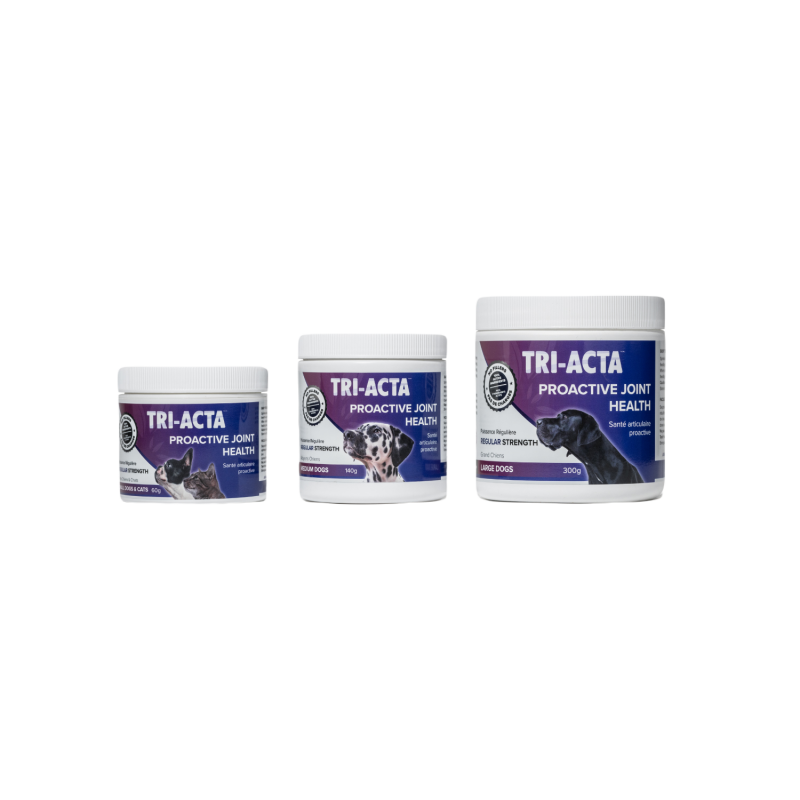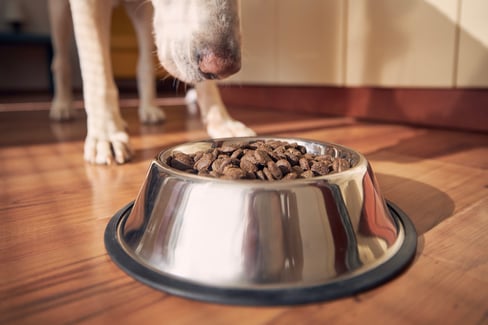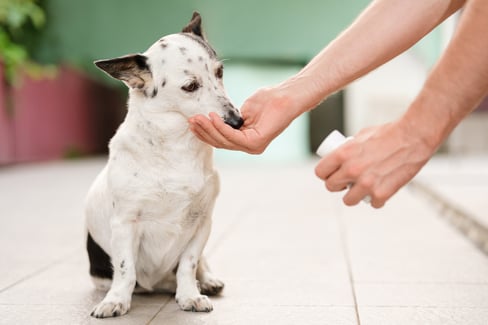Table of Contents
We love to run and play with our canine best friends. In fact, playing with a dog has been shown to lower blood pressure and release more feel-good hormones in our brains, oxytocin, and dopamine. These chemicals help reduce stress and contribute to overall positive mental health.
Plus, your dog enjoys playing with you, too! Playing not only strengthens the bond between you and your dog, but it also helps with their development, helping them develop obedience and social skills, as well as burn off extra energy and provide mental stimulation.
But sometimes playtime can be cut short by a joint injury. While any dog can potentially suffer a joint injury from particularly intense play, large dogs are more susceptible to joint injuries because of their rapidly-growing bones. For this reason, the American Kennel Club recommends that puppies should avoid extreme jumping until they reach at least 12–15 months and their growth plates are closed—but keep in mind that at any age, playtime that requires your dog to jump, twist, and contort their body can lead to hip and joint dogs injuries.
Even when you’re being careful with your pup during exercise and playtime, accidents can happen, and joint injuries can occur. Aside from injuries, joint issues in your dog can develop for a wide variety of reasons, including their breed, age, and genetics. It’s estimated that as many as 20% of all dogs over a year old will experience some form of joint issue in their lifetime.
Given the fact that it’s likely that your pup will develop a joint issue in their lifetime, it’s important to understand what you can do to prevent these issues, including proactive measures that you can take.
Common Causes of Poor Hip and Joint Health for Dogs
There are various reasons why your dog may develop a problem with their joints. These reasons include:
1. Injury
The first and most obvious cause of problems with hip and joint for dogs is injuries. Trauma from broken bones or dog muscle strain and sprains can result in joint injuries or increased degradation of the joints. In fact, secondary osteoarthritis, which means osteoarthritis that develops due to a previous joint injury, is believed to be the most common form of the disease in dogs.
If your dog suffers from a joint injury, chances are your vet will prescribe NSAIDs (non-steroidal anti-inflammatory drugs) to relieve your pup’s pain. While these medications are effective, they do come with negative side effects, similar to painkillers in humans. NSAIDs affect your dog’s liver, kidneys, and stomach; if they are used for long periods, the risk of liver and kidney failure and stomach ulcers increases. To prevent negative side effects, many dog owners will incorporate joint supplements into their dog’s diet so that NSAIDs can be reduced or eliminated over time.
A joint supplement like TRI-ACTA H.A. incorporated into your dog’s daily diet can amazingly affect your dog’s joint health. TRI-ACTA H.A. provides 100% active, therapeutic ingredients for your pup, including two types of glucosamine, chondroitin, Methylsulfonylmethane (MSM), and hyaluronic acid.
TRI-ACTA H.A. for Pets
Our maximum strength formula is optimally designed to accelerate the formation of cartilage, minimize inflammation, expedite the healing process, and improve joint conditions.

The purpose of these ingredients and their importance in the healing and joint maintenance process is described in the table below:
|
Joint Supplement Ingredient |
Purpose |
|
Glucosamine Sulfate / Glucosamine HCl |
|
|
Chondroitin |
|
|
MSM |
|
|
Hyaluronic Acid |
|
2. Breed
As we’ve seen from the statistics above, your dog’s breed can significantly contribute to their likelihood of developing joint problems. Conditions like dog arthritis and hip dysplasia dogs are common in dogs in general but especially in larger breeds. In fact, hip dysplasia is estimated to affect at least 70% of purebred dogs.
- In an evaluation of 138,902 German Shepherds, 20.6% of the dogs had some level of hip dysplasia.
- For Golden Retriever hip dysplasia, a study of 200 animals revealed a 53–73% prevalence of the joint condition.
- In the same study as the Golden Retrievers, out of 140 Rottweilers, the prevalence of hip dysplasia ranged from 41–69%.
3. Age
The body’s ability to repair and maintain the cartilage and other structures of the hip and joint for dogs decreases as they age. This is because their bodies are no longer producing as much glucosamine, an essential pet hip and joint ingredient that supports cartilage development and repair. Without the necessary ingredients to repair and maintain joint health, your dog’s joints will naturally start to deteriorate, which increases their risk of injuries.
Giving your aging pup a joint supplement with extra oomph like TRI-ACTA H.A. helps replace the necessary components of your dog’s joints that their body is having trouble producing enough of, helping to prevent joint injuries by strengthening their overall joint health.
4. Genetics
Another important factor that can significantly affect your dog’s joint health is genetics. When purchasing a puppy from a breeder, it’s extremely important to confirm that the breeder is reputable and that the puppy comes from a healthy lineage.
Recommendations from the Canadian Kennel Club provide sound advice for choosing a breeder:
- Meet the breeder (never buy a puppy from someone you haven’t met!) through phone and video calls, and be sure to visit the breeder directly for a meet and greet with the puppies. Observe their kennel (the premises where the puppies are being kept) to ensure they are raised in a loving, clean, and safe environment.
- Observe the behaviour and temperament of the puppies. See how they react to the breeder and yourself (as a stranger).
- Ask about the medical history of the puppies. A reputable breeder will be transparent about any health issues typical of the breed. The breeder should also be willing to provide health screening documentation.
- Meet the parents. As the saying goes, the apple doesn’t fall far from the tree. Meeting the puppy’s parents will give you a good idea of the puppy’s temperament and their appearance when they are adult dogs. If your breeder used a dam (female) and sire (male) from outside Canada, it’s important to confirm import requirements before sale.
You can refer to lists from the National Breed Club and the CKC Puppy List to find reputable and vetted breeders.
Factors for Optimal Hip and Joint for Dogs

To support hip and joint health for dogs, it’s important that you feed your dog a high-quality diet, provide comfortable and supportive bedding, give them joint supplements with glucosamine for dogs, and exercise and play with them appropriately.
1. Feeding a High-Quality Diet
If you’re feeding your pup food with plenty of fillers, preservatives, and additives, over time, it could affect their health. Just like if we eat greasy fast food every single day, the chances of us developing health conditions related to our diet increase.
And it isn’t just about the cost of the food, either. Whether cheap or expensive, you need to look for dog food that is nutritionally balanced and healthy for your dog. In particular, dogs need food that has protein but also contains essential nutrients like calcium, phosphorus, and vitamin D.
- Choose a dog food that’s right for your dog’s current stage of development. The dog food should list whether it’s for puppies, adult dogs, or seniors on the label or packaging. A statement on nutritional completeness, such as the phrase “complete and balanced”. A phrase on nutritional completeness indicates that the food can be fed as the dog’s main diet rather than a periodic treat.
- Check the ingredients. They are always listed from most to least on the label. Meat or poultry protein and byproducts should be among the first ingredients on the label of a good quality dog food. Be wary of meals, however—these often consist of feathers, animal stomach contents, and more, so while they can be labeled as “meat” as in “meat byproduct meal,” it may or may not contain actual meat as you’d think.
- Aside from meat, the food should also contain essential nutrients. As we mentioned, dogs need calcium, phosphorus, vitamin D, and more to maintain bone health. Other ingredients like probiotics (often fruits like cranberries and blueberries) can also help with digestive health.
2. Comfortable and Supportive Bedding
To support your dog’s hip and joint health, comfortable and supportive bedding can go a long way. Memory foam is one material that’s great for your dog’s joints, as it’s stiff yet comfortable and will support your dog’s joints equally no matter where they lay on the bed. A bed with rounded edges or a curved design also provides additional neck and back support. Of course, it’s also important to make sure you purchase a bed that’s the right size for your dog. They should have plenty of space to get comfortable. A tiny bed and a big dog don’t do much for joint support!
3. Incorporating Supplements into Your Dog’s Daily Routine
One of the most effective ways to support the health of hip and joint for dogs is to give them joint supplements. But while many joint supplements are on the market, not all of them are created equal. Here are a few essential considerations to remember before purchasing a supplement:
- Learn how to read a supplement label. Different manufacturers will have their own unique labelling systems for their supplements, meaning that the format of the ingredients list and the dosages will be different for each supplement. Understanding how many active versus inactive ingredients your pup is getting per dose is important. For example, if the product says that a dose contains 500 mg of glucosamine, 150 mg of chondroitin, and 50 mg of MSM, and the dosage is 1g (1000mg), that means 300 mg is dedicated to other ingredients, including fillers.
- Check designations. Regulatory bodies in North America provide a “seal” of approval on certain supplements, indicating that the ingredients are vetted, tested, and high-quality. These seals are usually indicated above the barcode on the product label. In Canada, there’s the Veterinary Health Product seal, and for products made in the United States, the NASC quality seal.
- Pick a formulation. Integricare recommends choosing a powdered joint supplement. Why? Powdered supplements like TRI-ACTA are easy to administer, often have small dosage amounts, and are often flavourless. Liquid supplements may not have enough therapeutic ingredients due to dilution, or you may have to feed a higher dose to get the same therapeutic benefit. Capsules are difficult to administer, and chewables often contain many inactive ingredients like flavourings, additives, and preservatives.
4. Appropriate Exercise and Play
Making sure you’re playing with your dog and facilitating appropriate exercise is essential pet hip and joint care. Fetch is a common game that dog owners like to play with their pups, but it should be done with caution.
Several studies investigating dogs that play a popular sport called flyball, which is a more intense version of fetch that includes obstacles, found that joint injuries were extremely common in the sport. The dog must jump and twist their bodies in flyball to catch a launched tennis ball. Other canine sports involving jumping, speed, and agility report similar injury levels. While regular play with your dog is likely not going to get as intense as these sports, it’s important to recognize that the common themes with twisting, jumping, and speed that are causing injuries in these sports. Large and giant breed dogs are especially susceptible to injury with these types of movements because of their weight and bone structure. At the end of the day, playing fetch is still ok, but you should avoid encouraging your dog to jump, twist, and contort their body to catch a frisbee or ball, as it could result in a serious joint or muscle injury.
If you have a senior dog or dog with joint issues, swimming is an activity that provides great exercise but has a low impact on their joints.
Proactive Hip and Joint Care for Puppies
If you’ve just got a new puppy, the last thing on your mind, as you wrangle them daily, is probably preventative joint care for puppies. The truth is that giving your puppy a joint supplement as soon as possible is a great way to help prevent them from developing joint issues or be more comfortable if they do end up developing a joint issue.
While you should always seek the advice of your veterinarian, as they can examine your puppy specifically, it’s generally fine to start giving your puppy joint supplements when they reach 12 months, as soon as their bones stop growing. However, some sources suggest giving your puppy supplements as early as 8 weeks if they are a breed that’s especially susceptible to joint issues, such as a Golden Retriever, German Shepherd, Labrador Retriever, or others.
Since sensitive puppy stomachs can be aggravated by ingredients like fillers, flavourings, and preservatives, choosing a joint supplement with as few inactive ingredients as possible is important. TRI-ACTA is a great proactive joint supplement choice for puppies, as it has 100% active ingredients, and dosages are small so that your puppy will barely notice it in their food.
TRI-ACTA for Pets
A proactive approach for developing and younger adult pets to maintain optimal joint health mobility, minimize inflammation and fend off age-related ailments.

Essential Hip and Joint Care for Senior Dogs
If you have an old dog, finding safe and effective ways to maintain their joint health becomes even more essential. Senior dogs should upgrade their joint supplement from TRI-ACTA to TRI-ACTA H.A. The “H.A” stands for hyaluronic acid, which improves the viscosity of the synovial fluid in your pup’s joints, giving them a freer range of movement and helping their joints feel more comfortable.
Other considerations you should consider to protect hip and joint dogs include:
- Exercising in moderation. While it’s important that your pup gets enough exercise, when they are a senior, they’re naturally going to want to slow down a bit. Taking your senior dog on short walks or a light swim are just a couple of examples of great ways you and your senior dog can get some fresh air and exercise together.
- Using area rugs or mats on slippery surfaces. Even senior dogs can have zoomies, and slippery surfaces can result in nails getting caught, broken, or ripped from your pup’s feet—ouch! Putting down area rugs or mats on slippery floors helps your dog get a grip when they need to.
- Invest in pet ramps or steps to help your dog get on the couch or bed. It can be tough for a senior dog with aching joints to put in the effort to climb up on the couch or bed to cuddle with you as much as they want to. Investing in pet stairs or a ramp, or making one yourself out of sturdy and non-slip material, is a good idea to prevent extra strain on your pup’s joints.
- Put food and water on an anti-slip mat. Your senior pup may be a bit more clumsy than they were in their younger years, so putting their food and water on an absorbent, non-slip mat is a good idea to prevent them from slipping on spilled water. If they are having trouble reaching down to eat or drink, consider getting them raised food and water bowls to make it easier for them to reach.
TRI-ACTA H.A. for Pets
Our maximum strength formula is optimally designed to accelerate the formation of cartilage, minimize inflammation, expedite the healing process, and improve joint conditions.

Additional Joint Solutions for Dogs

Aside from giving your dog joint supplements, making sure they get a diet consisting of high-quality food and treats, and ensuring that they get the right exercise, there are other ways that you can provide additional support for your dog’s joints.
|
Hip and Joint for Dogs Therapy / Supports |
Description |
|
Hydrotherapy |
Swimming is a great way to strengthen hip and joint health for dogs while not putting too much pressure on the joints themselves. |
|
Laser Therapy |
Specialized veterinarians use various types of laser beams emitted directly on the skin of the affected joint to provide pain relief, reduce inflammation, and encourage healing. |
|
Massage |
Stimulating your pup’s joints through massage helps with circulation, can reduce blood pressure, and helps relieve stiff and sore muscles. |
|
Kinesiology Tape |
This tape is made of thin, elastic cotton with an acrylic adhesive. The combination of stretch and adhesion reduces blood flow and applies pressure to an area to prevent swelling without restricting movement. Dog owners can apply kinesiology tape as long as they follow the right instructions. |
Summary
Effective hip and joint for dogs care involves a multifaceted approach, including diet considerations, providing a safe environment for them to relax, and ensuring that the exercise they get is appropriate.
One of the most effective ways to protect and heal your dog’s joints is by giving them joint supplements. TRI-ACTA products are formulated with 100% active, therapeutic ingredients, including glucosamine, chondroitin, and MSM, and for our extra-strength version, hyaluronic acid.Purchase TRI-ACTA online or find out where to buy in stores near you.
Newsletter Signup
Subscribe to our newsletter to receive the latest news and exclusive offers.
.jpg?height=2000&name=Cliick_Integricare-DISPLAY-REVISEDV2%20(1).jpg)
Proactive & Therapeutic Joint Supplements
When given daily, Integricare joint supplements recover bone and joint injuries faster and help prevent mobility injuries from happening in the first place.











